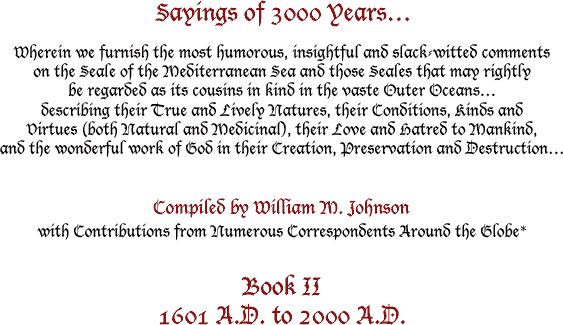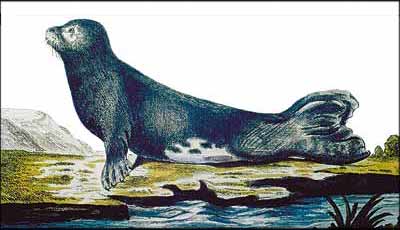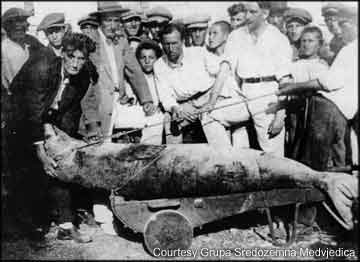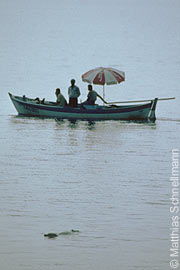 |
|
|
 |
||
 |
|
|
 |
||
Vol. 4 (1): May 2001
 |
|
TIMELINE
|
|
|
17th Century A.D. Sometimes sea bears enter the lagoon and cause great loss of fish. As they try to leave there for the open sea, great nets are stretched for them across the straits through which they have to pass. When they see themselves caught by them and attacked by the fishermen, they mount a surprising resistance. While they are trapped within the bay they often go along the shore letting themselves be seen without any fear, showing by certain actions they make that they understand everything that is said to them. And because I have never found myself present to witness such a thing, I scarcely allowed myself to be persuaded that a fish could understand what is said to it.
|
1633. Galileo summoned to Rome by the Inquisition to stand trial for “grave suspicion of heresy”. For supporting the Copernican notion that the Earth revolves annually around the sun, he is threatened with excommunication and death. After recanting, he is sentenced to life imprisonment – quickly commuted to permanent house arrest.
|
|
18th Century A.D. For some time I was undecided whether I should write down my observations, since the animal has already been on show around Germany for a year. But then I concluded that it could do no harm if there were several descriptions and illustrations of such a beautiful and rare animal.
|
Europe moves into the Age of Enlightenment – also known as the Age of Reason – propelled by a scientific rationalism that begins to seriously erode and undermine traditional religious beliefs and the power of the Church.
The Swedish naturalist Carolus Linnaeus (1707-1778) develops binomial nomenclature to classify and organize plants and animals. 1778: Captain James Cooke discovers the Sandwich Islands, now known as Hawaii. |
 From Hermann, 1779 |
|
|
19th Century A.D. During this month [December 1886] Mr. Henry L. Ward, of Rochester, son of Professor Henry A. Ward, the well-known ‘museum builder,’ visited the three little keys off the northwest coast of Yucatan known as the Triangles, for the express purpose of securing specimens of this rare animal [the Caribbean monk seal]… Forty-nine Seals were killed, forty-two of which were taken away, but one of them was afterward lost…
|
19th century: Powered by coal, Europe and America forge ahead in the Industrial Revolution.
Explorer-naturalists scour the world for animal and plant exhibits for zoos and museums. |
|
20th Century A.D. 1910 The pleasant animal quite enjoyed listening to the music of the bells and singing, but the real show started when playing on the harmonica was introduced in the experiment. Mr. Predic played softly and quietly different melodies. The monk seal raised its head from the water and started listening with curiosity and attentiveness. Afterwards, it lowered its head and closed its large and beautiful eyes occasionally, and almost fell asleep. This was repeated several times and all people present were impressed by this and convinced that the monk seal has an affinity for music. The entire experiment lasted 15 minutes. Mr. Predic had the appearance of an animal tamer. This experience was touching and magnificent and I will remember it for the rest of my life.
|
1914: With nationalism running rampant throughout Europe, the “war to end all wars” breaks out, eventually claiming some 20 million lives.
|
|
1930s My father must have killed 15-20 sea-bears [monk seals], I suppose. I remember there were plenty of seals around here then [in the 1930s]. First they killed the animal, then removed the skin from the body to let it dry and then cut the skin accordingly to produce “Çarik”. It was impossible to find shoes in those times so we had to wear Çarik. Our father used to provide us with Çarik made from ox skin because Çarik made from sea-bear skin was smelling [bad]. But we knew very well that Çarik from sea-bear skin was very strong compared to that from ox skin and also it was very good for rheumatism. My father used to sell or barter the sea-bear Çarik to the mountain villagers…
|
1917: The Russian Revolution begins with the arrival of Vladimir Ilich Lenin in Petrograd.
|
|
1943 But the best, and the most ludicrous, record is that of an old female Monk Seal whose stuffed skin and skeleton now lie alongside one another in the Fishery Laboratory in Alexandria. She was taken about ten years ago by fishermen in Port Said, who sent her in a box alive to Alexandria, where she quickly died, probably as a result of an extraordinary change of environment. The fishermen were convinced, a proof of the present rareness of the Monk Seal in the region, that this animal was a solitary wanderer from high northern latitudes. She therefore suffered the fate of being crammed alive into a box and sent by train closely packed in ice.
|
1922-1939. Fascism rises in Mussolini’s Italy and Hitler’s Germany, ushering in World War II.
1950s: The Cold War gathers pace, with both the USA and USSR developing Inter-continental Ballistic Missiles. |
|
1950 In freedom the monks prove to be of a perfectly sociable character. One of my friends, passionate amateur underwater hunter M. Delais, of the l’Office de le Recherche scientifique d’outre-mer, was swimming in their company and was but the object of an astonishing sympathy and a remarkable diving demonstration.
|
1953: Watson & Crick publish their discovery of the chemical structure of DNA
|
|
1960s The first of these “strange fishes” came out of the sea to a small beach where it was observed to have “whiskers like a man” and heard to “cry like a woman” when poked with a stick. Its eventual fate is not known, but it seems unlikely that it would survive the chastisement to which it was obviously subjected. The second specimen also attracted its crowd of curious onlookers. Fearing that it might be dangerous, it was destroyed by a home-made bomb.
|
1962: The Cuban Missile Crisis reaches its climax, with the United States and the Soviet Union on the brink of nuclear war.
|
 |
|
|
1978 Loss of habitat must be the candidate for the main cause of decline… Monk seals may have originally bred on open beaches, and their present habit of breeding in caves may simply be a retreat from the greater and greater encroachment by Homo sapiens. Several speakers at Rhodes questioned the suitability of caves as a monk seal habitat. It seems that grey seals that breed in caves produce fewer pups than those which use open beaches. For them, caves are a marginal habitat, mainly because they are flooded during storms and pups are easily drowned or separated from their mothers.
|
1974: Following the overthrow of Cyprus’ President, an act engineered by the military junta in Greece, Turkey invades and gains control of the northern third of the island.
|
|
1979 The tameness of unmolested seals to man could become a hazard if reserves are set up in close proximity to intensively exploited fishing grounds. A system of buffer zones is envisaged, possibly with compensation to fishers for damage to their nets in such areas as the price of allowing the seals to be unhunted. In such buffer areas, it is possible that some income could be obtained by fishermen serving as guides to visitors, which would offset to some extent the cost of payments to fishermen. Where unmolested the species should achieve its very remarkable degree of tameness and give pleasure to many people.
|
1979: At the instigation of World Wildlife Fund International (WWF), the International Union for Conservation of Nature and Natural Resources (IUCN), the Council of Europe and the Greek government, the First Biogenetic Reserve of Europe is approved for monk seals on the eastern Aegean island of Samos. Within a few months, the reserve is invaded by military and development interests.
|
|
“[They] trained the seals with the purpose of using them to spy for the Turks.”
|
1980: Amid great fanfare, WWF/IUCN and the United Nations Environment Programme launch the World Conservation Strategy, advocating a policy of sustainable development and sustainable use of natural resources.
1980: A military junta assumes power again in Turkey, declaring martial law and dissolving all political parties. |
|
1982 Coastal grapevine owners in Algeria claim that the seal will climb to the grapevines at night to eat the grapes, where grapevines are often grown close to the seashore.
|
1984: Morocco quits the Organization of African Unity to protest the seating of the Polisario movement, campaigning for independence of the western Sahara.
|
|
1985 The parties to the Barcelona Convention included among their priority targets to be achieved by 1995 the protection of the Mediterranean monk seal.
|
1984: Scientists discover the Ozone Hole over Antarctica, leading to fears over increases of ultraviolet radiation.
|
|
1986 [In these] six years of monk seal conservation we have had some interesting cases of interplay between man and seal, although we had not provoked the situations. On the 19th January 1990, when returning to the station in kayaks after a seal survey, we were surprised by loud roarings inside one cave at Furadinho [the Desertas Islands, Madeira], and suddenly a seal pup came to us swimming and barking, followed by the angry mother, that, holding the pup by the neck, took it inside the cave while roaring. A minute later the pup repeated the scene, and this time even tried to climb onto one kayak, which got the mother still more upset; in fact the adult came to us and [snarled] aggressively and took the pup again to the cave. The situation was repeated again and we decided to leave the area, noticing that the pup always came to the yellow kayak and not to the blue ones.
|
1988: Monk seal researcher Didier Marchessaux and several colleagues are killed in a landmine explosion in the western Sahara.
|
|
1988 “If we don’t get the seals it will be the end of this species. Let’s take advantage of the facilities at Antibes [Marineland]. Negative results could give us more valuable results than positive ones.”
|
1988: A U.N.-brokered cease-fire takes hold in the disputed territory of the western Sahara. Polisario guerrillas, however, resume attacks 14 months later, doubtful over Morocco’s commitment to achieving a lasting peace.
1989: People of East and West Germany dismantle the Berlin Wall. |
 |
|
|
1990 On 19 November, the Bellerive Foundation and the World Society for the Protection of Animals (WSPA), in association with the French environmental group Robin des Bois, took court action against the French Ministry of Environment and its decision to allow the importation of up to 7 monk seals by Antibes Marineland. The animals were to have been caught in caves just north of the Mauritanian border, in an operation spearheaded by British celebrity vet David Taylor. According to Marineland and the French Ministry of Environment, the seals would be used in an experimental captive breeding project. But the Bellerive/WSPA application for an injunction against the import asserts that there is no scientific support for Marineland’s plan, and that the transaction is motivated by commercial interests.
|
1991–1992: Slovenia, Croatia, Macedonia and Bosnia secede from Yugoslavia, igniting a vicious civil war in the Balkans.
1992: The Earth Summit convenes in Rio de Janeiro, Brazil. It is the largest gathering of world leaders in history, with 117 heads of state and representatives of 178 nations attending. 1992: Algeria erupts in civil war following military intervention to suspend a probable election victory by the Islamic Salvation Front. By 1995, the death toll reaches over 40,000 people. |
|
1996 In terms of behaviour, contrary to past reports, pups were observed to enter the sea within the shelters during the first week of life, even in the absence of their mother, while pups were observed to leave their shelter and swim in the vicinity alone in the second week of life… During the study, 11 pups were found to have changed shelters during their development and travel distances of several hundred meters at the age of two or three months old. On one occasion, a 10 day old pup was observed to have moved into a adjacent shelter covering a distance of at least 1500 meters.
|
1996: Greece and Turkey come to the brink of war over the disputed islet of Imia/Kardak in the eastern Aegean. An armada of warships confront each other in a tense stand-off in the disputed zone. Feverish international diplomacy finally persuades the potential combatants to withdraw.
|
|
1997 The largest population of the rare Mediterranean monk seal is in the western Sahara colony at Cap Blanc. The mean numbers in the period 1993-1996 were estimated as 317 individuals and the population was thought to be stationary or changing at a very low rate. In the spring of 1997 a severe mass mortality reduced the numbers by 70%, compromising the recovery of the species in the Atlantic.
|
1997: The world’s largest surviving monk seal colony, on the disputed Côte des Phoques of the western Sahara, is struck by a mass mortality event. Scientists are unable to determine whether the deaths are due to a morbillivirus or a toxic algae.
|
|
1999 Having read the earlier section on the management bureaucracy, one anonymous reviewer was moved to comment specifically on the “ponderous Byzantine, complicated bureaucracy that oversees actions relating to the Hawaiian monk seal… This specter,” the reviewer continued, “left me with the feeling that there was no hope for saving the monk seal from extinction… [a] conclusion [that] should be obvious to all readers.”
|
1999: 219 million tourists visit the Mediterranean, generating some 131 billion U.S. dollars. |
|
2000 The rate at which the monk seal populations are declining now precludes any notion of priority in the choice of protection measures. The only hope of saving the species resides in a strategy of an “attack on all fronts,” involving simultaneous use of all possible means.
|
2000: Beset by bureaucratic problems, the European Union cuts/delays essential funding to Greece and Turkey for frontline monk seal conservation projects.
|
*Contributors: Jasna Antolovic, Panos Dendrinos, Harun Güçlüsoy, William M. Johnson, David J. L. Johnson, Alexandros A. Karamanlidis, Cem Kiraç, David M. Lavigne, Yalçin Savas, Matthias Schnellmann, Eleni Tounta, Costas Triantafillou, Ozan Veryeri, Sue Wallace. Sources Aga Khan, S. Guest Editorial. A Little Imagination. The Monachus Guardian 2(2): November 1999. Allen, J.A. 1890. The West Indian Seal (Monachus tropicalis Gray). Bulletin of the American Museum of Natural History II (1887-90): 1-34. Anderson, S. 1978. A Monk in Retreat. New Scientist 78 (29 June): 906-808. Bertram, G.C.L. 1943. Notes on the Present Status of the Monk Seal in Palestine. Journal of the Society for the Preservation of the Fauna of the Empire 47: 20-21. Boulva, J. 1982. In: Ronald, K. & P.J. Healey. The Monk Seal (Monachus monachus). Vol. 4. Cetaceans, Seals, Sirenians and Otters. FAO Fisheries Series 5. Food and Agriculture Organisation of the United Nations (FAO), Advisory Committee on Marine Resources Research (ACMRR), Working Party on Marine Mammals, Mammals in the Seas: 243-252. Brusina, S. 1889. Sisavci jadranskoga mora. Rad Jugoslavenske Akademije, Zagreb Knjiga XCV (X): 79-177. Buffon, G-L. L. de. 1782. Supplément à l'Histoire Naturelle. Vol. XVI. L'Imprimerie Royale, Paris, France. Dendrinos, P., S. Kotomatas & E. Tounta. 1996. Monk seal Pup Production in the National Marine Park of Alonissos-N. Sporades. In: International Zoological Congress of the Hellenic Zoological Society, Athens, Greece, April 1996. Forcada, J., R. Pradel, M. Gazo & A. Aguilar. Demographic trajectory and projections of the Mediterranean monk seal population in the Western Sahara. Abstracts. The Society for Marine Mammalogy. 13th Biennial Conference on the Biology of Marine Mammals. Nov. 28–Dec. 3, 1999. Wailea, Maui, Hawaii: 58. Hermann, J. 1779. Abhandlung von der Münchs-Robbe. Beschäftigungen der Berlinischen Gesellschaft Naturforschender Freunde 4 (XIX): 456-509, Illstr. XII-XIII. Johnson, W.M. 1988. The Monk Seal Conspiracy. Heretic Books, London: 1-206. Internet edition: www.iridescent-publishing.com. Johnson, W.M. 1990. Bellerive Foundation Action Alert Newsflash, 6 December 1990. Lavigne, D.M. 1999. The Hawaiian Monk Seal: Management of an Endangered Species. Pages 246-266 in J.R. Twiss Jr. and R.R. Reeves (eds.). Conservation and Management of Marine Mammals. Smithsonian Institution Press, Washington and London: 1- 471. Mursaloglu, B. 1988. How to Save the Monk Seal, Commun. Fac. Sci. Univ. Ankara, Series C. Vol. 6: 227-233. Neves, H.C. 1986. Six years of protection and monitoring of the Monk Seal (Monachus monachus) in the Archipelago of Madeira. Unpublished ms. Funchal, Madeira: 1-18. Norris, W.J.T. 1972. Monk Seals in Libya. Oryx 16: 328-330. Postel, E. 1950. Un phoque tropical: le phoque moine. Nature 3187 (November 1950): 341-342. Regional Activity Centre for Specially Protected Areas (RAC/SPA), Tunis. 2000. Measures for the protection of the Mediterranean Monk Seal. www.rac-spa.org.tn/sealprot.htm. Repenning, C.A. 1980. Warm-blooded Life in Cold Ocean Currents: Following the Evolution of the Seal. Oceans Magazine (May 1980): 667-688. Sergeant, D., K. Ronald, J. Boulva, & F. Berkes. 1979. The Recent Status of Monachus monachus, the Mediterranean Monk Seal in: K. Ronald & R. Duguy, eds. First International Conference on the Mediterranean Monk Seal, Rhodes, Greece, 1978. Pergamon Press. Oxford, U.K.: 31-54. Spiegel, Der. 1981. Spionage. Schmutzige Bettler. 3 August 1981: 110. UNEP. 1985. Action Plan for the Management of the Mediterranean monk seal (Monachus monachus). Regional Activity Centre for Specially Protected Areas, Tunis: 1-30. Wijngaarden, A. van. 1962. The Mediterranean monk seal. From a Report to the Interntional Union for Conservation of Nature. Oryx. Fauna & Flora Preservation Society, London 6: 270-273. Zupanovic, S. 1966. Pojavljivanje, nestajanje i rasprostranjenje sredozemne medvjedice (Monachus monachus Hermann) u Jadranu. Drustvo za proucavanje i unapredjenje pomorstva, Zadar. Pomorski zbornik 4 (1966): 589-601. |
Copyright © 2001 William M. Johnson, The Monachus Guardian. All Rights Reserved